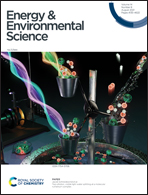Medium band-gap non-fullerene acceptors based on a benzothiophene donor moiety enabling high-performance indoor organic photovoltaics†
Abstract
Organic photovoltaics (OPVs) are one of the most promising technologies to power indoor electronic devices. However, the limited types and design strategies of medium band-gap acceptor materials hinder the development of indoor OPVs. Currently, the state-of-the-art non-fullerene acceptors (NFAs) are Y6 and its derivatives, which are based on an A–DA′D–A structure. In this paper, we report the modification of the Y6 structure by replacing Y6's D unit (thieno[3,2-b]thiophene) with benzothiophene, and synthesize two novel NFAs (LBT-DF and LBT-SCl) for indoor applications. The use of the benzothiophene unit reduces the intermolecular charge transfer effect, thus blue-shifting the absorption spectra and up-shifting the LUMO energy levels of the NFAs. As a result, LBT-SCl achieves a higher Voc and thus PCE (up to 25.1%) than Y6 (22.2%) under indoor conditions. Interestingly, these two NFAs exhibit a non-planar aromatic structure, which is rarely observed in the published NFAs, because a better coplanar molecular configuration is usually considered as the critical factor in realizing high PCE. Different from the above mentioned molecular design concept, we find that non-planar structure acceptors also have great potential in OPVs. Our work provides an effective OPV material design guideline for developing high-performance indoor OPVs and also opens a new direction for the design of NFAs.



 Please wait while we load your content...
Please wait while we load your content...